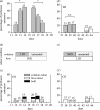Social learning of floral odours inside the honeybee hive
- PMID: 16191598
- PMCID: PMC1559887
- DOI: 10.1098/rspb.2005.3172
Social learning of floral odours inside the honeybee hive
Abstract
A honeybee hive serves as an information centre in which communication among bees allows the colony to exploit the most profitable resources in a continuously changing environment. The best-studied communication behaviour in this context is the waggle dance performed by returning foragers, which encodes information about the distance and direction to the food source. It has been suggested that another information cue, floral scents transferred within the hive, is also important for recruitment to food sources, as bee recruits are more strongly attracted to odours previously brought back by foragers in both honeybees and bumble-bees. These observations suggested that honeybees learn the odour from successful foragers before leaving the hive. However, this has never been shown directly and the mechanisms and properties of the learning process remain obscure. We tested the learning and memory of recruited bees in the laboratory using the proboscis extension response (PER) paradigm, and show that recruits indeed learn the nectar odours brought back by foragers by associative learning and retrieve this memory in the PER paradigm. The associative nature of this learning reveals that information was gained during mouth-to-mouth contacts among bees (trophallaxis). Results further suggest that the information is transferred to long-term memory. Associative learning of food odours in a social context may help recruits to find a particular food source faster.
Figures


References
-
- Bitterman M.E, Menzel R, Fietz A, Schafer S. Classical-conditioning of proboscis extension in honeybees (Apis mellifera) J. Comp. Psychol. 1983;97:107–119. - PubMed
-
- Chandra S.B, Hosler J, Smith B. Heritable variation for latent inhibition and its correlation with reversal learning in honeybees (Apis mellifera) J. Comp. Psychol. 2000;114:86–97. - PubMed
-
- De Marco R.J, Farina W.M. Changes in food source profitability affect the trophallactic and dance behavior of forager honeybees (Apis mellifera L.) Behav. Ecol. Sociobiol. 2001;50:441–449.
-
- Esch H.E, Zhang S.W, Srinivasan M.V, Tautz J. Honeybee dances communicate distances measured by optic flow. Nature. 2001;411:581–583. - PubMed
-
- Farina W.M. Food-exchange by foragers in the hive—a means of communication among honey bees? Behav. Ecol. Sociobiol. 1996;38:59–64.
Publication types
MeSH terms
LinkOut - more resources
Full Text Sources
Medical
Miscellaneous
